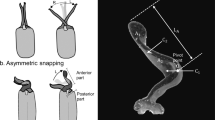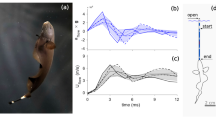These crustaceans can scare off predators even when their usual armour turns soft.
Abstract
Many arthropods are able to produce pulsed sounds by rubbing a hard pick over stiff macroscopic ridges1, rather like dragging a stick over a washboard. Spiny lobsters (Palinuridae) also make pulsed sounds, and here I show that they generate these by virtue of a frictional 'stick-and-slip' mechanism that is more usually associated with bowed stringed instruments. By using this technique rather than a 'hard-washboard' mechanism, lobsters can produce strident warning sounds against predators throughout their moult cycle, including the period when their exoskeleton is softened and they are most susceptible to predation.
This is a preview of subscription content, access via your institution
Access options
Subscribe to this journal
Receive 51 print issues and online access
$199.00 per year
only $3.90 per issue
Buy this article
- Purchase on Springer Link
- Instant access to full article PDF
Prices may be subject to local taxes which are calculated during checkout


Similar content being viewed by others
References
Ewing, A. W. Arthropod Bioacoustics: Neurobiology and Behaviour (Cornell Univ. Press, Ithaca, 1989).
Phillips, B. F., Cobb, J. S. & George, R. W. in The Biology and Management of Lobsters: Physiology and Behavior (eds Cobb, J. S. & Phillips, B. F.) 1–82 (Academic, New York, 1980).
Meyer-Rochow, V. B. & Penrose, J. D. J. Exp. Marine Biol. Ecol. 23, 191–209 (1976).
Benade, A. H. Fundamentals of Musical Acoustics (Dover, New York, 1990).
Fletcher, N. H. Acoustic Systems in Biology (Oxford Univ. Press, New York, 1992).
Paterson, N. F. Ann. S. Afr. Mus. 51, 1–232 (1968).
Mulligan, B. E. & Fischer, R. B. Crustaceana 32, 185–199 (1977).
Lindberg, R. G. Univ. California Publ. Zool. 59, 157–248 (1955).
Masters, W. M. Behav. Ecol. Sociobiol. 5, 187–200 (1979).
Aiken, D. E. in The Biology and Management of Lobsters: Physiology and Behavior (eds Cobb, J. S. & Phillips, B. F.) 91–163 (Academic, New York, 1980).
Moulton, J. Biol. Bull. 113, 286–295 (1957).
Author information
Authors and Affiliations
Corresponding author
Rights and permissions
About this article
Cite this article
Patek, S. Spiny lobsters stick and slip to make sound. Nature 411, 153–154 (2001). https://doi.org/10.1038/35075656
Issue Date:
DOI: https://doi.org/10.1038/35075656
This article is cited by
-
The composition and structure of fault gouge affect the magnitude and frequency of seismic activity in the Red River Fault Zone
Arabian Journal of Geosciences (2022)
-
A brief overview on mechanosensing and stick-slip motion at the leading edge of migrating cells
Indian Journal of Physics (2022)
-
Capillary grip-induced stick-slip motion
Nano Research (2022)
-
Spiny lobster sounds can be detectable over kilometres underwater
Scientific Reports (2020)
-
Underwater acoustic communication during the mating behaviour of the semi-terrestrial crab Neohelice granulata
The Science of Nature (2019)
Comments
By submitting a comment you agree to abide by our Terms and Community Guidelines. If you find something abusive or that does not comply with our terms or guidelines please flag it as inappropriate.



